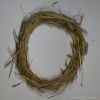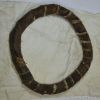 Pitch garlands, fire crowns or storm wreaths have appeared in martial treatises since the late 15th century. Their simple construction, however, suggests that they were known and used much earlier. Their military use did not end until the 19th century.
Pitch garlands, fire crowns or storm wreaths have appeared in martial treatises since the late 15th century. Their simple construction, however, suggests that they were known and used much earlier. Their military use did not end until the 19th century.
Pitch garlands or storm wreaths consisted of simple willow, straw or rope bundles that were laid into rings and wrapped with further pinned linen strips or rope strands. The materials of the wreaths were intensively nitrided in a saltpetre solution to increase their explosiveness. The surfaces were impregnated with pitch and black powder or sulphur.  Ignition strands could not be observed on the few rings preserved, so it is assumed that these were either applied shortly before use, or that the pitch wreaths were ignited without strands. The freshly lit wreaths were thrown onto the enemy ranks, where they burned aggressively with heavy smoke and ignited combustible equipment such as clothing, tents, siege equipment or ammunition supplies in their vicinity. In addition, they could be hung on chains in front of doors or gates during assaults to make it more difficult for the opponents to approach.1)2) The besiegers could throw ignited pitch wreaths from the outside through embrasures into the interior of the fortifications. There, the burning pitch wreath spread a dense, sulphurous smoke that obscured the crews' vision and, in combination with the humidity in the air, formed a sulphurous acid that burned the respiratory tract and eyes of those attacked and eventually forced them to flee the rooms. In addition, the wreaths could set fire to combustible materials or even the powder supplies there.3) Historic pitch wreaths are only very rarely preserved, such as in the art collections of the Veste Coburg, the Bavarian Army Museum4), the Reichstadtmuseum Rothenburg o. d. Tauber (Germany), at Historisches Museum Basel (Switzerland), Nordico Stadtmuseum Linz and the collections of Prince Esterházy at Forchtenstein Castle in Burgenland (Austria), the Stockholm Army Museum (Sweden) and in several private collections. Even rarer are burnt pitch garlads, such as pieces preserved in the Städitisches Museum Rosenheim (Germany), which date to the time of the Pandur invasions in 1742.5)
Ignition strands could not be observed on the few rings preserved, so it is assumed that these were either applied shortly before use, or that the pitch wreaths were ignited without strands. The freshly lit wreaths were thrown onto the enemy ranks, where they burned aggressively with heavy smoke and ignited combustible equipment such as clothing, tents, siege equipment or ammunition supplies in their vicinity. In addition, they could be hung on chains in front of doors or gates during assaults to make it more difficult for the opponents to approach.1)2) The besiegers could throw ignited pitch wreaths from the outside through embrasures into the interior of the fortifications. There, the burning pitch wreath spread a dense, sulphurous smoke that obscured the crews' vision and, in combination with the humidity in the air, formed a sulphurous acid that burned the respiratory tract and eyes of those attacked and eventually forced them to flee the rooms. In addition, the wreaths could set fire to combustible materials or even the powder supplies there.3) Historic pitch wreaths are only very rarely preserved, such as in the art collections of the Veste Coburg, the Bavarian Army Museum4), the Reichstadtmuseum Rothenburg o. d. Tauber (Germany), at Historisches Museum Basel (Switzerland), Nordico Stadtmuseum Linz and the collections of Prince Esterházy at Forchtenstein Castle in Burgenland (Austria), the Stockholm Army Museum (Sweden) and in several private collections. Even rarer are burnt pitch garlads, such as pieces preserved in the Städitisches Museum Rosenheim (Germany), which date to the time of the Pandur invasions in 1742.5)
Several dozen pitch wreaths from Hamburg are listed in an inventory of the city's fortifications from 1642, where they were part of the regular equipment of the bulwarks, towers, hornworks and armouries.6)


Straw Garlands
traw garlands are by far the easiest type of fire wreath to make. They simply consist of a twisted ring of straw wrapped with plant fibres. To increase the brisance of the straw garlands, they could be nitrated in a saltpetre solution.
Pitch Garlands
 The basic construction of the group 3 of pitch garlands according to VOGLER7) consists of a wreath of twisted branches around which a wicker ring of common osier (Salix viminalis) is woven. There were also examples whose inner stabilising ring consisted of a willow rod or a ring made of sheet iron. Pitch wreaths with a core made of a rope wreath braided with willow rods have also been handed down.8) Then the viscous burnt mass of pitch, sulphur and saltpetre was spread into the gaps. After drying, the wreath was wrapped with nitrided and freshly pitched linen strips and then coated again with pitch. The still sticky, pitched surface of the wreath was finally sprinkled with black powder, sulphur and possibly other binding agents against the sticky pitch.9)
The basic construction of the group 3 of pitch garlands according to VOGLER7) consists of a wreath of twisted branches around which a wicker ring of common osier (Salix viminalis) is woven. There were also examples whose inner stabilising ring consisted of a willow rod or a ring made of sheet iron. Pitch wreaths with a core made of a rope wreath braided with willow rods have also been handed down.8) Then the viscous burnt mass of pitch, sulphur and saltpetre was spread into the gaps. After drying, the wreath was wrapped with nitrided and freshly pitched linen strips and then coated again with pitch. The still sticky, pitched surface of the wreath was finally sprinkled with black powder, sulphur and possibly other binding agents against the sticky pitch.9)
Rope Wreaths
 The raw material for rope crowns or rope rings were strands of old, used-up hemp or flax ropes. These were nitrided in a saltpetre solution before processing. The substructure of group 1 rope wreaths according to VOGLER7) consist of a willow or hazel rod laid into a ring. The wreaths of group 2 consist of a twisted ring of rope strand; wreaths with a ring of sheet iron have also been handed down. This were knitted around once or twice with rope strands. Finally, the structure was pricked with coniferous tar and, as evidenced in some specimens, sprinkled with fine black powder.7) In addition to these specimens, there are pitch rings that were built on a nitrided rope ring with textile wrapping and a tar and powder coating and are assigned to group 4 according to VOGLER.10)
The raw material for rope crowns or rope rings were strands of old, used-up hemp or flax ropes. These were nitrided in a saltpetre solution before processing. The substructure of group 1 rope wreaths according to VOGLER7) consist of a willow or hazel rod laid into a ring. The wreaths of group 2 consist of a twisted ring of rope strand; wreaths with a ring of sheet iron have also been handed down. This were knitted around once or twice with rope strands. Finally, the structure was pricked with coniferous tar and, as evidenced in some specimens, sprinkled with fine black powder.7) In addition to these specimens, there are pitch rings that were built on a nitrided rope ring with textile wrapping and a tar and powder coating and are assigned to group 4 according to VOGLER.10)
Younger Pitch or Storm Wreaths
Pitch or storm wreaths of the 16th and 17th centuries featured much more refined designs. Authors such as Ernst Braun, Wilhelm Dillich, Leonhardt Fronsperger and Casimir Simienowicz, for example, suggested spiking the wreaths with "Mordschlägen" crackers and grenades to make it more difficult to approach the burning wreaths for defusing or extinguishing attempts, or to equip the wreaths with barbed iron tips so that they would snag on the enemy's equipment and clothing.11)
Reconstructions
 We have undertaken reconstruction experiments of various pitch garlands, mainly building non-flammable display models using non-nitrated linen and coal or non-flammable ash instead of black powder. Combustible specimens were built for experimental purposes, which were burnt under controlled conditions.
We have undertaken reconstruction experiments of various pitch garlands, mainly building non-flammable display models using non-nitrated linen and coal or non-flammable ash instead of black powder. Combustible specimens were built for experimental purposes, which were burnt under controlled conditions.
Pitch Garlands
Our reconstruction experiments of group 3 pitch garlandswere built on a basic framework of braided wicker, with multiple pinned line winding and final powdering with a black powder substitute.
Another set of pitch wreaths was built on a ring of nitrided straw wrapped with nitrided linen strips with a coating of tar and sulphur. The still sticky layer of tar was then powdered with charcoal dust, instead of the original's powdered charcoal.
On 04.05.2014, we conducted our first burn test of a brisant pitch garland. This pitch garland was built on a straw core with a winding of nitrided linen and a coating of sulphur and tar. On top of this was another layer of linen that had been pitched and powdered with carbon powder. Overall, the experiment was not completely satisfactory. The ring did not ignite until about 2 minutes after the ignition fuse was lit. The active burning phase was too long with just over 4 minutes. Overall, the ring burned down much too slowly and harmlessly. Two other pitch wreaths were burnt in front of an audience at a historical event in Lich (Hesse, Germany). These pitch wreaths also ignited after about 2 minutes, but then burned down faster and with a much stronger smoke development.
Rope Wreaths
 Reconstruction attempt of group 2 rope rings from old untwisted ropes. For this purpose, rope strands were laid into a ring and wrapped with further strand. Finally, the wreath was pricked and sprinkled with sawdust. The rope rings made for demonstration purposes were made of non-nitrided rope material. Practical tests with reconstructed rope wreaths were carried out by the Medieval Gunpowder Research Group at Middelaldercentret Nykøbing, Denmark.12)
Reconstruction attempt of group 2 rope rings from old untwisted ropes. For this purpose, rope strands were laid into a ring and wrapped with further strand. Finally, the wreath was pricked and sprinkled with sawdust. The rope rings made for demonstration purposes were made of non-nitrided rope material. Practical tests with reconstructed rope wreaths were carried out by the Medieval Gunpowder Research Group at Middelaldercentret Nykøbing, Denmark.12)
Experimental Burning of Pitch Garland
Experimental burning of the first pitch wreath we reconstructed. All in all, this pitch wreath burned too harmlessly, slowly and with far too little smoke development. This was mainly due to construction errors and the wrong tar, as we used beech tar due to the lack of softwood tar. Later reconstructions worked more promisingly, as can be seen in the adjacent photo, but even these were still not optimal.
References

- Geibig (2012): pp. 47-72
- Geibig (2007)
- Courtesy of Dr. Alfred Geibig, Kunstsammlungen der Veste Coburg
- Schönauer, Hohrath (2019): p. 215
- Inv. Nr. 579, courtesy of Walter Leicht, Städtischen Museum Rosenheim.
- Neddermeyer (1832): pp. 57-62
- Vogler (2007): pp 79-81
- Vogler (2007): pp. 54-55
- Vogler (2007): pp. 53-58
- Vogler (2007): pp. 39-52
- Vogler (2007): pp. 62-71
- Smith (2010): pp. 103-108
Text: Andreas Franzkowiak
Potos: Pitch garlands: Marcus den Toom, Andreas Vollborn-Rahn, and Sothebys; Zossen straw wreath Hartmut F. Reck Märkische Allgemeine Zeitung; Experimental burning Chris Wenzel; Andreas Franzkowiak
Video: Chris Wenzel















